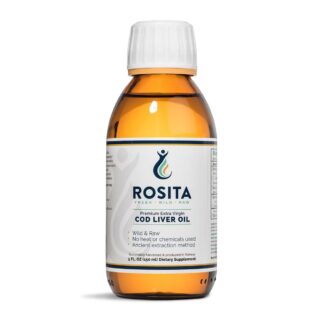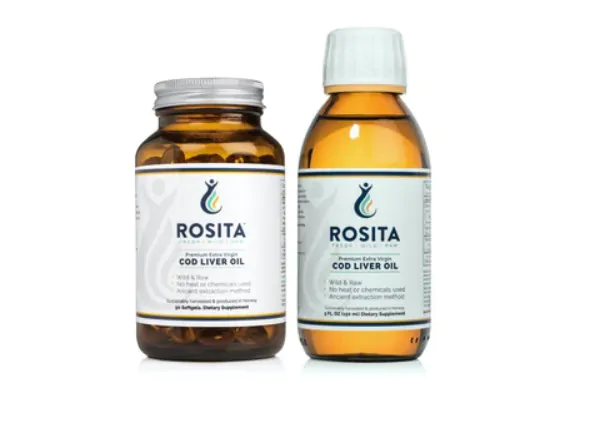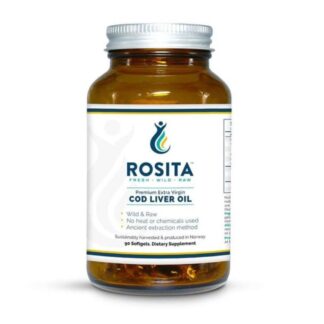Rosita Extra Virgin Cod Liver Oil (EVCLO) Liquid
150 ml
47 in stock
-
Nutrient dense:Contains 100% naturally occurring nutriens: vitamins A and D, and a full spectrum of omega fatty acids (including EPA and DHA); no synthetic vitamins.
Sustainable:Authentic cod are caught hook and line on our own fishing boats in Norway.
Unprocessed & raw:Oil is quickly and naturally released - without heat, chemicals or mechanics.
Rosita Extra Virgin Cod Liver Oil is the only fresh, wild-caught and raw cod liver oil in the entire world. Straight from pristine Norwegian seas, it contains naturally occurring vitamins A and D, and a full spectrum of omega fatty acids, including omega-3 EPA and DHA.
If you do the research, you’ll find that most commercial cod liver oils are highly processed with heat that wipes out the natural vitamins A and D, and damages the fragile omega-3 fatty acids. To make up for the loss, most cod liver oil producers will add synthetic vitamins.
Yet Rosita's family is in control of the entire process from fish to bottle, giving you the most precious and nutritional cod liver oil on the market.
- Sustainable: Authentic cod (gadus morhua) are sustainably caught, hook and line on Rosita’s own fishing boats off the coast of northern Norway.
- Unprocessed: Raw and handcrafted in small batches using a rare, exclusive and generations-old cold-process extraction technique that turns to nature to separate the oil from the livers (with a gentle temperature shift). No heat, bleach, solvents, mechanics, winterisation or chemicals are used.
- Fresh: Fish to fresh oil within hours!
-
Rich nutrients & no synthetic vitamins: Contains only naturally-occurring vitamin A and vitamin D and a full spectrum of omega-3 fatty acids in the concentration and proportion nature intended:
o Gives you 360 IU vitamin D3 per teaspoon and 3,663 IU vitamin A per teaspoon (with some variation batch-by-batch due to naturally occurring seasonal shifts).
o Gives you 443 mg EPA and 605 mg DHA per teaspoon, along with a full spectrum of omega fats, including 3 (DHA and EPA), 4, 6, 7, 9 and 11. -
Ships safely in all temps: Nitrogen-flushed, oxygen-free glass bottle protects the oil’s nutrients and allows for shipping in all temperatures, even without cold packs.
- Safe: Each batch is 3rd-party tested in a microbiological laboratory and certified to meet strict European regulations for potency and purity. You can read the results here.
- Natural antioxidants: A tiny drop of rosemary herb and full spectrum vitamin E (from sunflower seeds) is added to maintain freshness.
- Taste: Golden oil tastes like robust, wild-caught fish. Nothing added to mask your oil’s all-natural taste.
Absorption benefits of liquid cod liver oil
Because Rosita Extra Virgin Cod Liver Oil is fresh, wild-caught and raw, taking a spoonful of the liquid is akin to eating a piece of nutrient-rich, fresh fish. This means your body will recognise Rosita as real food, rather than a processed supplement.
In addition, the vitamins in your Rosita cod liver oil are fat-soluble, meaning they’re more likely to be stored in the body’s fat and used as needed.
Rosita liquid versus softgels
Rosita liquid cod fish oil offers more servings compared to softgels. This makes it excellent value for the entire family’s needs.
Rosita liquid is also helpful for those who cannot swallow a softgel, or who prefer a smooth dose.
Wild & Raw Extra Virgin Cod Liver Oil (fish) (99.91%), Rosemary extract (0.04%) and non-GMO Vitamin-E (0.05%).
Why add Rosemary and Vitamin E?We add a small amount of rosemary extract and vitamin E in the form of mixed tocopherols. The vitamin E that we use in our products is a full spectrum vitamin containing alpha-, beta-, gamma-, and delta-tocopherols. The source of vitamin E is a non-GMO Sunflower extract from Denmark.
We use No Artificial Flavours, Colours or Preservative. Our oil is naturally Soy, Gluten and Dairy free
Allergens: Fish
Best taken with food, as needed.
How to take Rosita liquid
Here are some quick tips on “prepping” your pure cod liver oil for the most optimal taste:
- Before taking your preferred dose, take it out of the fridge and set it on the counter for two minutes.
- Then shake! This allows your oil to be properly distributed (it’s a full-spectrum oil, so shaking it makes for a consistent taste).
- Some people like to enjoy a slice of orange afterward for a refreshing chaser.
Key Nutritional Facts*
1293
MG
Omega-3s per serving
150
ML
Per Bottle
360
IU
Vitamin D per serving

Testing
HOW WE TEST OUR EXTRA VIRGIN COD LIVER OIL
Rosita Extra Virgin fish oils are tested by the following leading European Institutes (listed below) to make sure our products are pure, fresh and clean. Each batch of undergoes rigorous testing for heavy metals, organic contaminants, oxidation, bacteria, microplastics, and radioactivity. Test results are available upon request.
EUROFINS - Eurofins is an international group of laboratories headquartered in Luxembourg, providing testing and support services to the pharmaceutical, food, environmental, agriscience and consumer products industries and to governments.
ALS Food & Pharmaceutical (UK) - ALS provide a comprehensive range of microbiological, physical and chemical testing services combined with industry leading technical expertise and customer service.
Biodetection Systems B.V. (BDS) - To protect our health and the environment by offering and applying innovative, sensitive, and efficient in vitro test methods – that is what BioDetection Systems stands for.
All productions are tested for contaminants before being bottled and released for sale.
Please find the test results for the latest productions of Rosita Premium EVCLO 150ml in the table below:
| WHO PCDD/F-TEQ |
WHO-PCDD/F PCB-TEQ |
PCB 28-52-101-138-153-180 |
|
| EU REGULATION | 1.75 pg/g | 6.00 pg/g | 200 ng/g |
| NORWEGIAN REGULATION | 1.75 pg/g | 4.00 pg/g | 200 ng/g |
|
Test results Rosita Extra-Virgin Cod Liver Oil (EVCLO): |
|||
| EVCLO - Production date: September 28. 2020 (Testing by EUROFINS Report #440-2020-1002-025) - Best Before (Fridge/Freezer): NOV.28.2021/2023 |
0.219 pg/g | 1.53 pg/g | 93.2 ng/g |
| EVCLO - Production date: August 03. 2020 (Testing by EUROFINS Report #440-2020-0811-055) - Best Before (Fridge/Freezer): OCT.03.2021/2023 |
0.435 pg/g | 0.837 pg/g | 74.2 ng/g |
| EVCLO - Production date: July 02. 2020 (Testing by EUROFINS Report #440-2020-0710-270) - Best Before (Fridge/Freezer): SEP.02.2021/2023 |
0.342 pg/g | 0.844 pg/g | 90.8 ng/g |
| EVCLO - Production date: April 30. 2020 (Testing by EUROFINS Report #440-2020-0506-044) - Best Before (Fridge/Freezer): JUN.30.2021/2023 |
0.326 pg/g | 0.721 pg/g | 74.8 ng/g |
| EVCLO - Production date: February 12. 2020 (Testing by EUROFINS Report #440-2020-0218-010) - Best Before (Fridge/Freezer): APR.12.2021/2023 |
0.343 pg/g | 0,874 pg/g | 157 ng/g |
| EVCLO - Production date: December 06. 2019 (Testing by EUROFINS Report #440-2019-1210-090) - Best Before (Fridge/Freezer): Feb.06.2021/2023 |
0.283 pg/g | 0.948 pg/g | 104 ng/g |
| EVCLO - Production date: October 05. 2019 (Testing by EUROFINS Report #440-2019-1008-064) - Best Before (Fridge/Freezer): Dec.09.2020/2022 |
0.327 pg/g | 0.588 pg/g | 48.1 ng/g |
| EVCLO - Production date: August 08. 2019 (Testing by EUROFINS Report #440-2019-0809-028) - Best Before (Fridge/Freezer): Oct.08.2020/2022 |
0.340 pg/g | 0.718 pg/g | 89.9 ng/g |
| EVCLO - Production date: July 01. 2019 (Testing by EUROFINS Report #440-2019-0709-096) - Best Before (Fridge/Freezer): Sep.01.2020/2022 |
0.425 pg/g | 1.026 pg/g | 100 ng/g |
| EVCLO - Production date: April 07. 2019 (Testing by EUROFINS Report #440-2019-0409-011) - Best Before (Fridge/Freezer): JUNE.04.2020/2022 |
0.316 pg/g | 0,984 pg/g | 108 ng/g |
| EVCLO - Production date: March 04. 2019 (Testing by EUROFINS Report #440-2019-0308-076) - Best Before (Fridge/Freezer): MAY.04.2020/2022 |
0.337 pg/g | 0.92 pg/g | 106 ng/g |
| EVCLO - Production date: January 17. 2019 (Testing by EUROFINS Report #440-2019-0128-008) - Best Before (Fridge/Freezer): MAR.17.2020/2022 (MAR ==> March) |
0.33 pg/g | 0.85 pg/g | 98.3 ng/g |
| EVCLO - Production date: October 30. 2018 (Testing by EUROFINS Report #440-2018-1108-052) - Best Before (Fridge/Freezer): DES.30.2019/2021 (DES ==> December) |
0.35 pg/g | 1.11 pg/g | 121.0 ng/g |
| EVCLO - Production date: July 21. 2018(Testing by EUROFINS Report #440-2018-0802-031) - Best Before (Fridge/Freezer): SEP.21.2019/2021 |
0.34 pg/g | 1.02 pg/g | 90.1 ng/g |
| EVCLO - Production date: April 07. 2018 (Testing by EUROFINS Report #440-2018-0419-083 and BDS - Report #13479-1) - Best Before (Fridge/Freezer): APR.07.2019/2021 |
0.3 pg/g | 0.6 pg/g | 66.9 ng/g |
| VCLO - Production date: March 09. 2018 (Testing by EUROFINS Report #440-2018-0315-018 and BDS - Report #13357-1)) - Best Before (Fridge/Freezer): MAR.09.2019/2021 |
0.3 pg/g | 0.6 pg/g | 135 ng/g |
| EVCLO - Production date: February 24. 2018 (Testing by EUROFINS Report #440-2018-0308-052) - Best Before (Fridge/Freezer): FEB.24.2019/2021 |
0.339 pg/g | 1.13 pg/g | 141 ng/g |
| EVCLO - Production date: January 19. 2018 (Testing by EUROFINS Report #440-2018-0125-075) - Best Before (Fridge/Freezer): JAN.19.2019/2021 |
0.338 pg/g | 0.944 pg/g | 89.0 ng/g |
| EVCLO - Production date: December 06. 2017 (Testing by EUROFINS Report #440-2017-1211-100) - Best Before (Fridge/Freezer): DEC.06.2018/2020 |
0.338 pg/g | 1.20 pg/g | 104.0 ng/g |
| EVCLO - Production date: September 01. 2017 (Testing by EUROFINS Report #440-2017-0905-025 and BDS - Report #12471-1) - Best Before (Fridge/Freezer): Sep.01.2018/2020 |
0.300 pg/g | 0.60 pg/g | 132.0 ng/g |
| EVCLO - Production date: July 20. 2017 (Testing by EUROFINS Report #440-2017-0724-016 and BDS - Report #12284-1) - Best Before (Fridge/Freezer): JUL.20.2018/2020 |
0.230 pg/g | 0.23 pg/g | 84.9 ng/g |
| EVCLO - Production date: April 21. 2017 (Testing by EUROFINS Report #440-2017-0424-021 and BDS - Report #11859-1) - Best Before (Fridge/Freezer): APR.21.2018/2020 |
0.300 pg/g | 1.30 pg/g | 83.7 ng/g |
| EVCLO - Production date: March 27. 2017 (Testing by EUROFINS Report #440-2017-0328-087 and BDS - Report #11724-1) - Best Before (Fridge/Freezer): March 27.2018/2020 |
0.300 pg/g | 1.20 pg/g | 90.5 ng/g |
| EVCLO - Production date: March 06. 2017 (Testing by EUROFINS Report #440-2017-0307-065 and BDS - Report #11628-1) - Best Before (Fridge/Freezer): March 06.2018/2020 |
0.300 pg/g | 1.00 pg/g | 113.0 ng/g |
| EVCLO - Production date: February 21. 2017 (Testing by EUROFINS Report #440-2017-0206-058 and BDS - Report #11581-1) - Best Before (Fridge/Freezer): Feb.21.2018/2020 |
0.460 pg/g | 3.50 pg/g | 138.0 ng/g |
| EVCLO - Production date: February 1. 2017 (Testing by EUROFINS Report #440-2017-0124-100 and BDS - Report #11433-1) - Best Before (Fridge/Freezer): Feb.01.2018/2020 |
0.300 pg/g | 2.60.pg/g | 81.8 ng/g |
| EVCLO - Production date: November 25. 2016 (Testing by EUROFINS Report #440-2016-1129-022 and BDS - Report #11170-2) | 0.300 pg/g | 0.81 pg/g | 117.0 ng/g |
| EVCLO - Production date: August 15. 2016 (Testing by EUROFINS Report #440-2016-0727-020 and BDS - Report #10427-1) | 0.300 pg/g | 3.80 pg/g | 128.0 ng/g |
| EVCLO - Production date: July 25. 2016 (Testing by EUROFINS Report #440-2016-0608-085 and BDS - Report #9786-2) | 0.700 pg/g | 1.70 pg/g | 110.0 ng/g |
| EVCLO - Production date: May 24. 2016 (Testing by EUROFINS Report #440-2016-0510-063 and BDS - Report #9387-1) | 0.700 pg/g | 2.00 pg/g | 97.9 ng/g |
| EVCLO - Production date: April 04. 2016 (Testing by EUROFINS Report #440-2016-0331-052 and BDS - Report #9005-1) | 0.600 pg/g | 1.60 pg/g | 134 ng/g |
| EVCLO - Production date: February 05. 2016 (Testing by EUROFINS Report #440-2016-0113-005 and BDS - Report #8001-2) | 0.400 pg/g | 2.70 pg/g | 162 ng/g |
| EVCLO - Production date: December 01. 2015 (Testing by EUROFINS - Report #440-2015-1125-102) | 0.342 pg/g | 3.15 pg/g | 178 ng/g |
| EVCLO - Production date: October 15. 2015 (Testing by BDS - Report # 7365-1) | 0.110 pg/g | 0.70 pg/g | 171 ng/g |
| EVCLO - Production date: September 28. 2015 (Testing by EUROFINS - Report #440-2015-0922-007) | 0.343 pg/g | 3.13 pg/g | 172 ng/g |
The concentration of fat-soluble nutrients depends on several biological factors, including the size of the fish and the amount of oil contained in the liver. There are also seasonal variations related to the spawning cycle of the fish, climatic conditions, plankton, and other conditions affecting the codfish. Because Rosita EVCLO is a completely unrefined & unprocessed wholefood, the concentration of nutrients will ALWAYS vary from batch to batch.
The Nutrient Results (fat-soluble vitamins, sterols & fatty acids) shown below represent typical values and ranges which have been obtained from analytical testing at the following institutes:
- NIFES (National Institute of Nutrition and Seafood Research )[20/12/2010]
- ALS Food & Pharmaceutical (United Kingdom) [10/10/2012]
- Eurofins Food Testing [19/02/2013]
- Nutrition Analytical Service (NAS), Institute of Aquaculture, University of Stirling, Scotland, United Kingdom [15/11/2013]. The head of NAS, Professor Gordon Bell, has over 30 years of experience in fish nutrition and lipid and nutrition related analysis and has published more than 184 peer-reviewed papers on fish nutrition, fatty acids, lipid soluble nutrients and antioxidants. The Chief Analyst, James Dick, provides over 25 years of experience in lipid methodology and is responsible for Quality Control within the Nutrition Group, the development of chromatographic techniques and is trained in all aspects of complex lipid analysis including HPLC, GC, GC/MS and GC/MS/MS.
- Extra virgin oil was also tested [as far back as: 15.07.2011] by the producer at ECO-Marine using a Norwegian Aquaculture Research Institute which specialises in marine raw materials and products.
VITAMIN E (ALPHA-TOCOPHEROL) ANALYSIS
|
SAMPLE ID |
mg/teaspoon |
|
Wild & Raw EVCLO |
3.7-10 |
VITAMIN A (RETINOL) ANALYSIS
|
SAMPLE ID |
iu/teaspoon |
|
Wild & Raw EVCLO |
3000-5000 |
VITAMIN A2 (3,4-DEHYDRORETINOL) ANALYSIS
|
SAMPLE ID |
mg/kg |
|
Wild & Raw EVCLO |
> = 0.1 |
VITAMIN D3 (CHOLECALCIFEROL) ANALYSIS#
|
SAMPLE ID |
iu/teaspoon |
|
Wild & Raw EVCLO |
400-500 |
RATIO VITAMINS A:D
|
SAMPLE ID |
ratio |
|
Wild & Raw EVCLO |
Typically less than 10:1 |
STEROL CONTENT
|
SAMPLE ID |
mg/Kg |
|
Wild & Raw EVCLO |
|
|
CHOLESTEROL |
4044-5245 |
|
BRASSICASTEROL (PHYTOSTEROL) |
40.4 |
|
Rest to follow |
|
Select Fatty Acid Composition of Total Lipid from Wild & Raw EVCLO
|
Fatty acid |
mg/teaspoon |
|
20:5n-3 (EPA) |
510 |
|
22:6n-3 (DHA) |
700 |
|
18:1n-9 (Oleic acid) |
1,200 |
|
20:1n-9 (Gadoleic acid)* |
660 |
|
22:1n-11 (Cetoleic acid)* Fatty acids, Sum of Omega 6 Calc. Fatty acids, Sum of Omega 3 Calc. Unidentified fatty acids |
375 160 1,460 240 |
|
ratio |
|
|
DHA/EPA∆ |
1:1 – 1.3:1 |
|
Omega 6/Omega 3 Ratio |
0.11 |
∆This ratio is a good indicator of genuine Northern hemisphere cod liver oil.
Cod Liver Oil has been tested for purity by leading European institutes and meets all the stringent European requirements.
HEAVY METAL CONTENT
[ALS Food & Pharmaceutical (UK): 10/10/2012]
|
SAMPLE ID |
Wild & Raw EVCLO |
|
MERCURY |
n.d |
|
CADMIUM |
n.d |
|
LEAD |
n.d |
|
ARSENIC |
1.4 ppm* |
ppm - parts per million
n.d - not detected
*organic (non-toxic) form
HEAVY METAL ANALYSIS
[BioDetection Systems b.v. (BDS): 19/03/2013]
|
SAMPLE ID |
Wild & Raw EVCLO |
|
MERCURY |
n.d |
|
CADMIUM |
n.d |
|
LEAD |
n.d |
|
ARSENIC |
1.8 ppm* |
ppm - parts per million
n.d - not detected (the concentration of the analyte is below the limit of quantification).
*organic (non-toxic) form
ORGANIC CONTAMINANTS [Dioxins and PCBs, Benzo(a)pyrene]
Certificate of Analysis from:
- ALS Food & Pharmaceutical (UK) [10/10/2012]
- BioDetection Systems b.v. (BDS) [19/03/2013]
Cod liver oil has been analysed in triplicate and each time gives a total WHO-PCDD/F-PCB-TEQ lower than the strict European limits and well within them. The values for the oil are in line with QC parameters.
A. POLYAROMATIC HYDROCARBONS
|
SAMPLE ID |
BENZO(A)PYRENE
(mg/kg)
|
|
Wild & Raw EVCLO |
<0.001# |
#the concentration of the analyte is below the limit of quantification
Above value calculated from analyses performed in duplicate.
B. DIOXINS and PCBs
- Sum of dioxins (WHO-PCDD/F-TEQ): 0.20 ng/kg#
- Sum of dioxins and dioxin-like PCBS (WHO-PCDD/F-PCB-TEQ): 0.899 ng/kg#
#Maximum levels set by the European Commission for thesum of dioxins (WHO-PCDD/F-TEQ) for marine oils (fish body oil, fish liver oil and oils of other marine organisms intended for human consumption): 1.75 ng/kg fat
#Maximum levels set by the European Commission for thesum of dioxins and dioxin like PCBs (WHO-PCDD/F-PCB-TEQ) for marine oils (fish body oil, fish liver oil and oils of other marine organisms intended for human consumption): 6.0 ng/kg fat
#Dioxins (sum of polychlorinated dibenzo-para-dioxins (PCDDs) and polychlorinated dibenzofurans (PCDFs), expressed as World Health Organisation (WHO) toxic equivalent using the WHO-toxic equivalency factors (WHO-TEFs)) and sum of dioxins and dioxin-like PCBs (sum of PCDDs, PCDFs and polychlorinated biphenyls (PCBs), expressed as WHO toxic equivalent using the WHO-TEFs). WHO-TEFs for human risk assessment based on the conclusions of the World Health Organization (WHO) – International Programme on Chemical Safety (IPCS) expert meeting which was held in Geneva in June 2005 (Martin van den Berg et al., The 2005 World Health Organization Re-evaluation of Human and Mammalian Toxic Equivalency Factors for Dioxins and Dioxin-like Compounds. Toxicological Sciences 93(2), 223–241 (2006))
C. BDS DR CALUX technique: another screening method for dioxins and dioxin-like PCBs
|
SAMPLE ID |
Method |
Parameter |
Result |
Unit |
|
Wild & Raw EVCLO |
DR CALUX |
PCDD/PCDF and dl-PCBs (total BEQ; semi) |
compliant (1.7) |
ng BEQ/kg product |
The DR CALUX analysis is done according to p-bds-051.
All DR CALUX analysis results comply with EU requirements as indicated in COMMISSION REGULATION (EC) No 278/2012 (amending Regulation (EC) No 152/2009 as regards the determination of the levels of dioxins and polychlorinated biphenyls; feedstuffs).
TOTOX ANALYSIS
Extra virgin oil was also tested by the producer at ECO-Marine using a Norwegian Aquaculture Research Institute which specialises in marine raw materials and products. Extra virgin oil was also tested as far back as 15.07.2011
|
SAMPLE ID |
PEROXIDE VALUE * |
ANISIDINE VALUE * |
TOTOX * |
|
Wild & Raw EVCLO |
4.8 |
2.2 |
11.8 |
PV expressed as Meq/Kg
AV expressed as anisidine value units
TOTOX = 2PV+AV
TOTOX ANALYSIS
|
SAMPLE ID |
PEROXIDE VALUE * |
ANISIDINE VALUE * |
TOTOX * |
|
Wild & Raw EVCLO |
0.38 |
0 |
0.76 |
PV expressed as Meq/Kg
AV expressed as anisidine value units
TOTOX = 2PV+AV
TOTOX ANALYSIS
Extra virgin oil was also tested by the producer at ECO-Marine using a Norwegian Aquaculture Research Institute which specialises in marine raw materials and products. Extra virgin oil was also tested as far back as 15.07.2011
|
SAMPLE ID |
PEROXIDE VALUE * |
ANISIDINE VALUE * |
TOTOX * |
|
Wild & Raw EVCLO |
2.9 |
6.6 |
12.4 |
PV expressed as Meq/Kg
AV expressed as anisidine value units
TOTOX = 2PV+AV
TBAR ANALYSIS
|
SAMPLE ID |
TBARS (mg/kg) |
|
Wild & Raw EVCLO |
0.25 |
Above value calculated from analyses performed in duplicate.
TBARs are expressed as mg/kg for feeds and oil and nmole/g tissue for flesh or other tissues.
[Extra virgin oil was also tested by the producer at ECO-Marine using a Norwegian Aquaculture Research Institute which specialises in marine raw materials and products. Extra virgin oil was also tested as far back as 15.07.2011]
|
SAMPLE ID |
A as Oleic |
|
Wild & Raw EVCLO |
0.6 |
|
SAMPLE ID |
mg KOH/g |
|
Wild & Raw EVCLO |
1.2 |
MICROBIOLOGICAL CONTENT
[ALS Food & Pharmaceutical (UK): 10/10/2012]
|
SAMPLE ID |
cfu/ml |
|
Wild & Raw EVCLO |
|
|
Total Viable Count |
<1 |
|
Coliforms (presumptive) |
0 |
|
Escherichia coli (presumptive) |
<1 |
|
Yeasts |
<2 |
|
Moulds |
<2 |
|
Salmonella sp. (ELISA) |
Not detected / 25g |
|
Calories 45 |
Calories from Fat 45 |
|
|
% Daily Value* |
|
Total Fat 4.5g |
7.0% |
|
Saturated Fat 0.9g |
4.5% |
|
Trans Fat 0g |
0% |
|
Cholesterol 18mg |
6% |
[Performed by a third party, independent Norwegian laboratory].
- Shelf-life of unopened bottles at a temperature of 0-4 °C is 12 months.
- For storage at -20 °C the shelf-life is 2-3 times longer.
- Shelf-life after the bottles are opened at 0-4 °C is 2-3 months.
- Testing has shown that vitamins and other substances found in Rosita EVCLO are not affected by freezing and remain completely intact.
- In summary, the oil must be kept dark and cold.
Customer Reviews 1
5.00
Based on 1 reviews
(1)
(0)
(0)
(0)
(0)
ENDORSED BY





You may also like…







Md. Aktaruzzaman Nayem –
Test